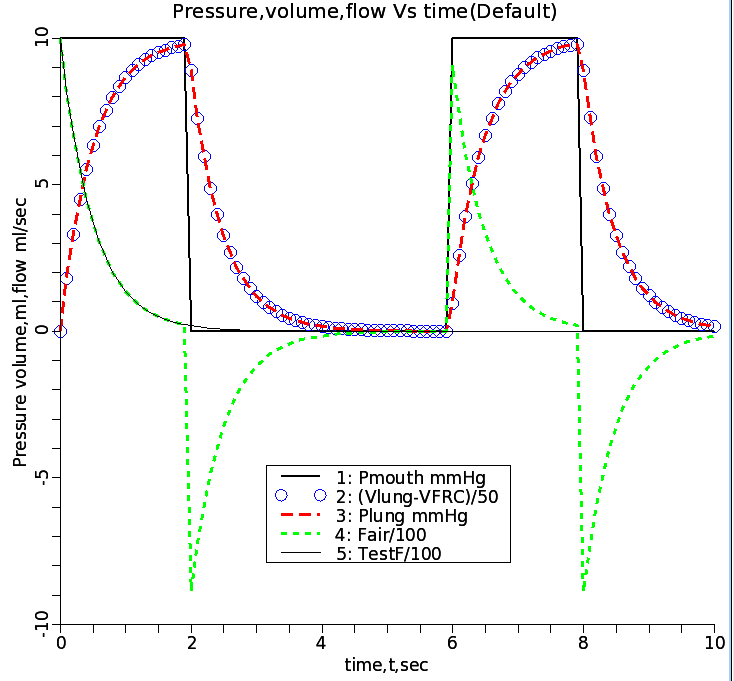A compliant 1 compartment lung with resistance to air flow, driven by external positive pressure ventilator.
Description
The equations governing airflow in and out of a one compartment lung are
given by the following analogy to electrical circuits:
Airway pressure is analogous to voltage.
Air flow is analogous to current flow.
Volume is analogous to charge.
Resistance to air flow is analogous to electrical resistance.
Compliance, the relationship between pressure and volume, is
analogous to capacitance, the relationship between charge
and voltage.
The model shows that various quantities are governed by exponential decay
with time constant tau=R*Com.
The main assumption is that the human lungs can be approximated as a single
compartment modeled by an RC circuit where the quantities of interest, air
flow, volume of air, pressure, compliance, and resistance are analogous to
current, charge, voltage, capacitance, and resistance respectively.
GENERAL RESULTS: The ventilator, using a driving pressure of 10 mmHg gives
an approximately normal tidal volume of 500 ml. Normally of course, the force
is provided by expansion of the chest, creating a negative pressure in the
intrapleural space, just the oppposite of this positive pressure ventilator.

Figure: Pressure, volume, flow vs. time. The forcing ventilator pressure is Pmouth (black). The numerical solutions:Fair Flow at mouth (green dashes), Volume circles; Plung red dashes. TestF is black line (exp(-t/Res*com)), a verification test fitting Fair(t).
Equations




where Pmouth is the pressure at the mouth; P atmos, Ref pressure, external to body; Pvent, the driving pressure from a ventilator; ScalPvent, scaler of amplitude of Pvent; Plung is the pressure in the lung; Fair is the air flow at the mouth; R is the resistance of the airway; Com is the compliance of the lung; VFRC is the functional residual capacity of the lung; and Vlung is the volume of air in the lung.
The equations for this model may be viewed by running the JSim model applet and clicking on the Source tab at the bottom left of JSim's Run Time graphical user interface. The equations are written in JSim's Mathematical Modeling Language (MML). See the Introduction to MML and the MML Reference Manual. Additional documentation for MML can be found by using the search option at the Physiome home page.
- Download JSim model MML code (text):
- Download translated SBML version of model (if available):
We welcome comments and feedback for this model. Please use the button below to send comments:
M.G. Levitsky, Pulmonary Physiology, Sixth Edition, McGraw Hill, 2003.
Please cite https://www.imagwiki.nibib.nih.gov/physiome in any publication for which this software is used and send one reprint to the address given below:
The National Simulation Resource, Director J. B. Bassingthwaighte, Department of Bioengineering, University of Washington, Seattle WA 98195-5061.
Model development and archiving support at https://www.imagwiki.nibib.nih.gov/physiome provided by the following grants: NIH U01HL122199 Analyzing the Cardiac Power Grid, 09/15/2015 - 05/31/2020, NIH/NIBIB BE08407 Software Integration, JSim and SBW 6/1/09-5/31/13; NIH/NHLBI T15 HL88516-01 Modeling for Heart, Lung and Blood: From Cell to Organ, 4/1/07-3/31/11; NSF BES-0506477 Adaptive Multi-Scale Model Simulation, 8/15/05-7/31/08; NIH/NHLBI R01 HL073598 Core 3: 3D Imaging and Computer Modeling of the Respiratory Tract, 9/1/04-8/31/09; as well as prior support from NIH/NCRR P41 RR01243 Simulation Resource in Circulatory Mass Transport and Exchange, 12/1/1980-11/30/01 and NIH/NIBIB R01 EB001973 JSim: A Simulation Analysis Platform, 3/1/02-2/28/07.

